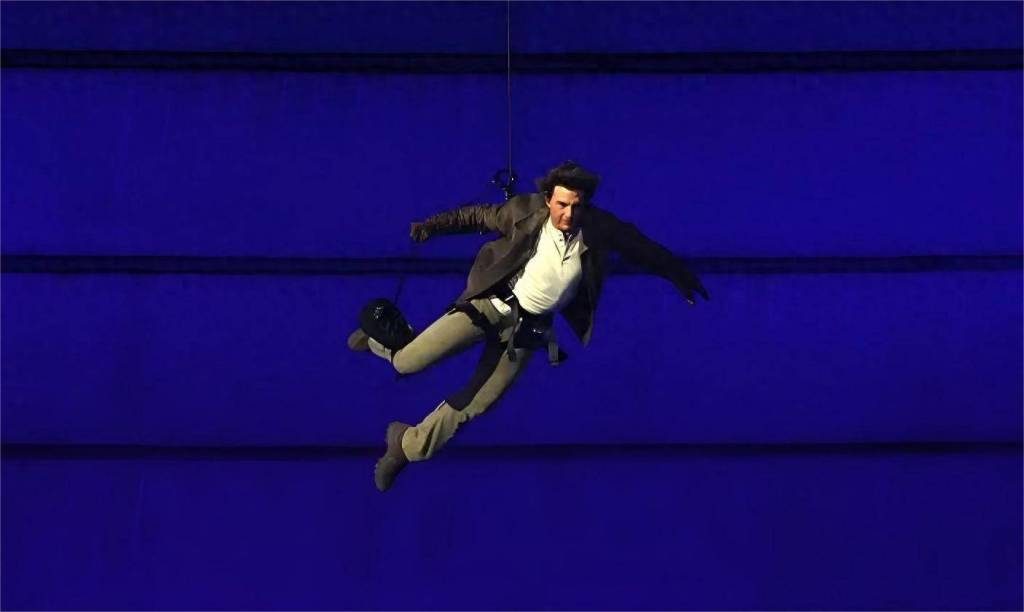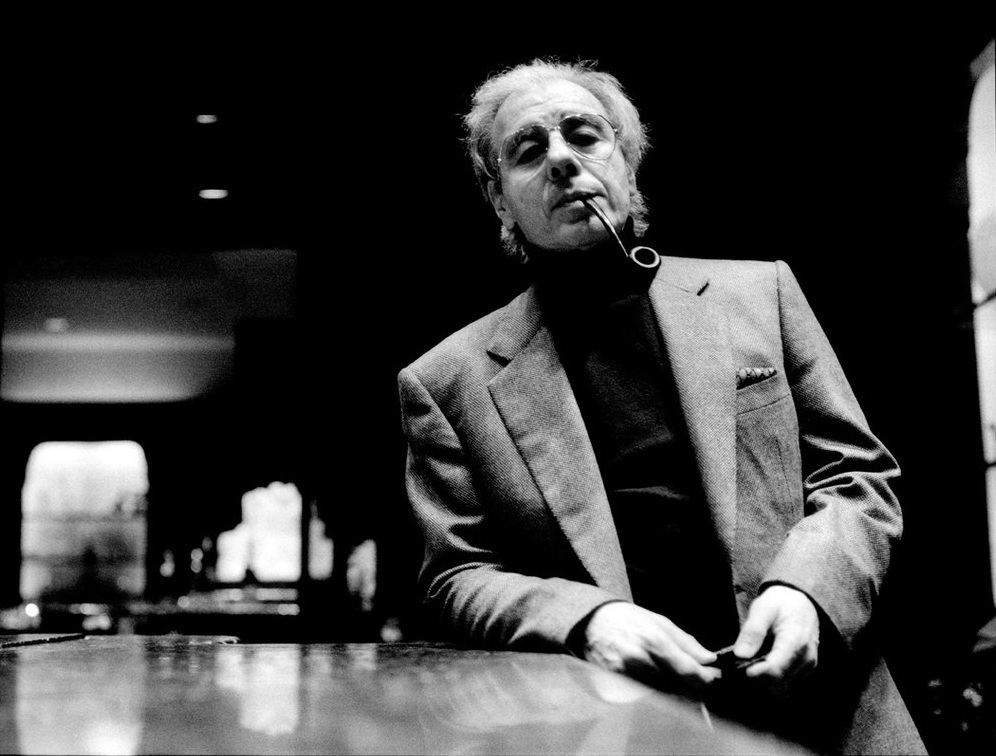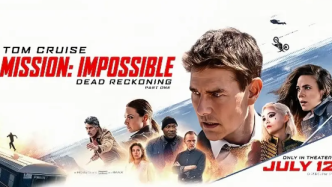
When CG special effects powered by artificial intelligence are so realistic that they can be mistaken for real, why would a person still risk his life to go up to the sky and explore the sea, making every shoot like a large-scale reality show to record and promote? This can be said to be Cruise's way of dealing with the social network era, and it is also a flesh-and-blood person holding the torch in the face of the technological boom.
On August 11, 2024, accompanied by the opening theme song of Mission: Impossible, which was played in Morse code, Tom Cruise rappelled from the roof of the Stade de France, took the Olympic flag and put it on his Harley-Davidson motorcycle, sped through the streets of Paris, and drove into a Hercules transport plane that had been waiting for a long time. When he flew over Los Angeles, the host city of the next Summer Olympics, he did a BASE jump (low-altitude parachute) over the Hollywood Hills, and then covered the "five rings" firmly on the white "HOLLYWOOD" sign on the top of the mountain.
Under the attention of the world, this set of Ethan Hunt's iconic action scenes was completed in one go. Not only did it make the "Mission Impossible" in film history the latest footnote to the Olympic spirit of "Higher, Faster, Stronger and More United", it also showed that this movie star in his sixties is no longer just an actor, but a genuine hero who has stepped from the screen into the real world.

Tom Cruise recreates classic action scenes from Mission: Impossible at Paris Olympics closing ceremony
When writing a review for any Mission: Impossible movie, no matter how you evaluate the film itself, it is inevitable to praise the desperate spirit and professional skills of the lead actor and producer Tom Cruise himself, and the latest film in the series, Final Reckoning, which is currently being screened in China, is no exception. In the film, Ethan and his IMF team face an invisible enemy for the first time: an out-of-control AI system "Intelligence" that intends to destroy humanity. This plot setting is not new, but it is particularly appropriate at this "singularity" moment when we are discussing how carbon-based and silicon-based organisms can coexist.

Mission: Impossible 8: Reckoning "Hell or High Water" Art Poster
“I bought the whole seat and only sat on the edge”
From the diligent "Andy Lau" on the screen to the "Jackie Chan" who creates characters through action, Tom Cruise's turning point may be "Born on the Fourth of July" directed by Oliver Stone in 1989. This is Cruise's most ambitious work in the 1980s, and it is his desperate charge towards the Oscar statuette. The movie tells the story of a boy named Ron Kovic who was originally passionate about the American spirit, but witnessed the darkness of war in the Vietnam War, lost his legs and faith, and became an anti-war propagandist. There is a scene in the film where Ron, after paralyzed in the lower body, still walks around with a cane, but accidentally falls and breaks his paralyzed leg again. It is a pity that this effort in the name of the American "Independence Day" still did not win Cruise's favor from the Academy, but became a portrayal of his image as a hard worker in the future.
After the 1990s, Cruise, who was already a superstar, expanded his career to set up his own company to produce films. His first work as a producer was "Mission: Impossible" released in 1996. The film was adapted from the American TV series of the same name, which is an adventure story centered on spy operations and requires constant mask changing. Since then, the first seven "Mission: Impossible" series films have earned nearly $5 billion in box office worldwide and have been defined as "not another Hollywood blockbuster."

Tom Cruise and director Brian De Palma on the set of Mission: Impossible 1
Director Brian De Palma, known as the "American Hitchcock", injected the horror elements of film noir into the first Mission: Impossible. Brian once recalled that when filming the scene where Ethan blew up a giant aquarium weighing three tons with a gum bomb and escaped, the art department originally planned to shoot with a miniature model, but Cruise flatly rejected it, saying, "The audience can tell the difference between real and fake." He insisted on completing it in a 1:1 real scene, and for this he was willing to endure fatal threats: at the moment the water tank exploded, more than 300 jagged fragments burst out at the speed of bullets, the closest to his face was only 30 centimeters; 2,000 gallons of water were released in an instant in 0.8 seconds, with an impact force equivalent to being hit by a truck, and he had to cross a 12-meter passage before suffocating, and he had to keep his eyes open throughout the performance.
This shot, which lasted nearly 12 seconds in the film, was repeated 28 times during three days of shooting to capture the "elegant struggle" that the two wanted - in slow motion, Cruise leaped like a ballerina, and the scene of hair and glass fragments dancing in the beam of light became the most unforgettable poetic moment in the history of action movies. He then ran all the way on the cobblestone road in Prague, with his knees raised to the level of his hip joints and his arms splitting the airflow at a 90-degree angle, which became another of his signature moves.

Tom Cruise's running style has become his signature move
This scene was edited into the trailer of Mission: Impossible. It was this shot that opened the way for Cruise to advance his stunts in the series of films, such as climbing the cliffs of Utah, climbing the Burj Khalifa (828 meters) like Spider-Man, and jumping onto the exterior facade of the cabin door of an Airbus A-400M transport plane after takeoff. None of these scenes were shot in front of a green screen and supplemented with special effects synthesis.

Stills from Mission: Impossible 5: Rogue Nation
Director John Woo recalled the scene in Mission: Impossible 2 (2000) when Tom Cruise requested to climb the cliffs of Dead Horse Point in Utah by himself, that is, to complete the so-called "free solo" scene. He insisted on doing this scene, which really made me angry. I tried to stop him, but it was completely useless. I was so nervous that I was sweating all over. I didn't even dare to look at the monitor screen during the filming. This is exactly the effect Cruise wants to achieve in the cinema. "I hope that the audience can immerse themselves in it, not just sit there. We like to hear them say the most, 'I bought the whole seat, but I only sat on the edge.'"

Stills from Mission: Impossible 2
“Action means nothing without an emotional connection to the character”
It should be said that the Chinese title of this series of movies, "Mission Impossible", was very prescient: the key target of the first operation was an ordinary CD containing a list of CIA spies, which was a synonym for high technology in that era; at the end of the latest "Mission Impossible 8: Final Reckoning", Ethan and his team fought against the self-aware AI and wanted to lock this "intelligence" in a five-dimensional optical drive USB flash drive. It is a perfect closed loop.

Stills from Final Reckoning
Since "Final Reckoning" is temporarily the final chapter of the series, it is necessary to pay tribute to the previous works. Writer and director Christopher McQuarrie did not just touch on the surface with flashbacks: the MacGuffin "Rabbit's Foot" in "Mission Impossible 3" turned out not to be a biological weapon, but a source of "intelligence". Even more surprising is the return of CIA analyst William Donlow (played by Rolf Saxon). In the first film, he was just a background board in the classic scene of Ethan "hanging" into the vault full of alarm sensors at the CIA headquarters. In the latest movie, he was sent to the monitoring station at the North Pole because of his dereliction of duty last time, and became a key figure in Ethan's team confirming the location of the crash of the "Sevastopol" nuclear submarine.

Stills from Mission: Impossible
Considering that the real-world Russian-Ukrainian conflict had not yet broken out when the script was written, this plot not only coincidentally echoes the current situation, but is also a masterstroke of "movie fandom" that is extremely friendly to movie fans. McQuarrie worked as a security guard in a movie theater in New Jersey for four years before officially entering the industry. He described this experience as "his own film school", which helped him develop an innate perception ability, "the ability to see through the audience's reaction to the movie". This talented screenwriter, who won the 68th Academy Award for Best Original Screenplay for the movie "The Usual Suspects" at the age of 26, has collaborated with Tom Cruise on 11 movies and has been the exclusive director of this series of movies since "Mission: Impossible 5: Rogue Nation" in 2015.

Stills from Final Reckoning
"I no longer focus on style, but put emotion first." McQuarrie pointed out, "We will continue to accumulate emotion and depth in each movie, and the portrayal of Ethan and other supporting characters will also be more in-depth, and the expression of emotion will be pushed to a deeper level..." This undoubtedly allows the "Mission Impossible" sequels in the past decade to avoid the criticism of "form over content" to a large extent, and to explore and amplify Cruise's performance characteristics that have already appeared in his early film "The Color of Money" (1983). "He knows how to hint at the whole world through what he doesn't say, can't feel, and can't understand."

Stills from Final Reckoning
McQuarrie knows that action may help build character, but action for the sake of action is meaningless. "If there is no emotional connection with the character, the action is meaningless, it's just a spectacle. So in every movie, we learned how to create an emotional atmosphere." From this we can look at two big scenes in "Final Reckoning" that Cruise personally performed: the search inside a nuclear submarine under the Bering Sea ice cap, and the dogfight between two old Stearman biplanes in the sky of Drakensberg in South Africa.

Stills from Final Reckoning
For the former, Cruise had to do deep-sea diving for up to 1 hour and 15 minutes each time, wearing a mask that restricted the oxygen entering the lungs. The submarine itself is a manifestation of a high-pressure environment, and the clumsiness of his movement in the cabin stems from the real restraint of wearing 80 kg of diving equipment; for the latter, the temperature of the antique plane drops by 3 degrees Celsius for every 1,000 feet it rises. At a speed of 150-170 miles per hour, Cruise not only has to perform wing walking, but also hang his body upside down on it. McQuarrie gave a description that ordinary people can understand, "When a car is driving at high speed, you can feel the impact by sticking your hand out of the window. Now imagine sticking your whole body out of the window, against a hurricane, because that's what he did."
Looking at the film art that has evolved over the past 130 years, the release of Final Reckoning this year also creates a double metaphor between text and reality - when the CG special effects enabled by artificial intelligence are enough to be indistinguishable from the real thing, why would a person still risk his life by going to the sky and exploring the sea, making every shoot like a large-scale reality show that is recorded and promoted? It can be said that this is Cruise's way of dealing with the social network era, and it is also a flesh-and-blood body holding a torch against the wind on the eve of the technological boom.

Stills from Final Reckoning

